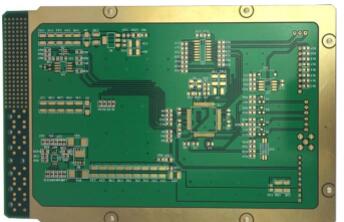The high frequency of electronic equipment is a development trend, especially with the increasing development of wireless networks and satellite communications, information products are moving towards high-speed and high-frequency, and communication products are moving towards the standardization of voice, video and data for wireless transmission with large capacity and speed. Therefore. The new generation of products that are developing all require high-frequency boards. Communication products such as satellite systems, mobile phones and base stations must use high-frequency circuit boards. In the next few years, they will develop rapidly, and high-frequency substrates will be in large demand.
The basic characteristics of high-frequency board materials are as follows:
1. Other heat resistance, chemical resistance, impact strength, peel strength, etc. must also be outstanding.
2. Low water absorption and high water absorption will affect the dielectric constant and dielectric loss when damp.
3. The thermal expansion coefficient of the copper foil should be as common as possible, because the difference will cause the separation of the copper foil in the cold and heat changes.
4. The dielectric loss (Df) must be small, which primarily affects the quality of signal transmission. The smaller the dielectric loss, the smaller the signal loss.
5. The dielectric constant (Dk) must be small and stable. Usually the smaller the better. The signal transmission rate is inversely proportional to the square root of the data dielectric constant. High dielectric constant is likely to cause signal transmission delay.
Generally speaking, a high-frequency board can be defined as a frequency above 1GHz. At present, the most commonly used high-frequency circuit board substrate is a fluorine dielectric substrate, such as polytetrafluoroethylene (PTFE), which is usually called Teflon, and is usually used Above 5GHz. In addition, FR-4 or PPO substrates are also used, which can be used for products between 1GHz and 10GHz. The physical properties of these three high-frequency substrates are compared as follows.

At this stage, the three types of high-frequency substrate materials: epoxy resin, PPO resin and fluorine resin are the cheapest cost of epoxy resin, and the most expensive fluorine resin; and the dielectric constant, dielectric loss, and water absorption. Considering the frequency characteristics, fluorine resin is the best and epoxy resin is inferior. When the frequency of the product application is higher than 10GHz, only the fluorine-based resin printed board can be applied. Obviously, the fluorine-based resin high-frequency substrate has much higher functions than other substrates, but its shortcomings include high cost and poor rigidity and large thermal expansion coefficient.
For high-frequency board polytetrafluoroethylene (PTFE), in order to improve the function, a large amount of inorganic substances (such as silica SiO2) or glass cloth are used as reinforcing filling materials to improve the rigidity of the substrate and reduce its thermal expansion. In addition, due to the molecular inertness of the high-frequency board PTFE resin itself, it is not easy to form a poor bond with the copper foil, so special surface treatment of the bonding surface with the copper foil is required. The treatment method includes chemical etching or plasma etching on the surface of the high-frequency board PTFE, adding surface roughness or adding a layer of adhesive film between the copper foil and the high-frequency board PTFE resin to improve the bonding force. However, it may have an impact on the function of the medium. The development of the entire fluorine-based high-frequency circuit substrate requires the cooperation of original data suppliers, research units, equipment suppliers, high-frequency PCB manufacturers, and communication product manufacturers. Keep up with the rapid development of high-frequency circuit boards in this category.
There are many precautions when planning circuit boards for high-frequency boards, especially GHz-level high-frequency circuit boards. It is also necessary to pay attention to the influence of the length of each electronic component pad and printed pattern on the circuit characteristics. In recent years, high-frequency circuits and digital circuits share the same circuit board. The so-called mixed-load circuit system seems to have an increasing trend. Planning similar to this often results in digital circuit operations, but high-frequency circuits are unstable. One of the reasons is that the noise generated by the digital circuit affects the normal operation of the high-frequency circuit. In order to prevent the above problems, in addition to trying to divide the two circuit blocks, it is the basic method to fully reflect on the planning concept before planning the circuit board. Basically, the following three principles must be grasped when planning the circuit board for high-frequency boards
1.61548, high quality;
2.61548, no tricks;
3.61548, do not rush to grab time.
International laminated board FR-4 A grade copper clad laminate functional value
Typical value of standard value of style treatment of test item
1. Peeling strength pounds/inch, 1/2OZ/Ft square copper foil acceptance status A≥6.07.0-8.0, thermal stress A≥6.07.0-8.0, 1OZ/Ft square copper foil acceptance status A≥8.010.0, Thermal stress A≥8.010.0;
2. Solderability A can be welded and welded;
3. Bending and warping% A plate thickness is 1.68mm0.1/0.25;
4. Surface resistance, minimum value, MΩE-24/125≥≥;
5. Water absorption% thickness (thickness) 0.781mm0.350.2;
6. Volume resistance, minimum value, MΩ.cmE-24/125≥≥;
7. Glass transition temperature, Tg(DSC, degree Celsius)A≥125133~138;
8. Flame retardancy A/&E-1/105desUL94V0UL94V0;
9. Dielectric constant, 1MHz, MaxC-40/23/505.44.8;
10. Arc resistance, minimum value, second D-48/50D-0.5/23≥6080;
11. Breakdown voltage, minimum value (KV), step thickness ≥0.51mm D-48/50D-0.5/23≥4070;
12. Electric strength, minimum value (KV/mm), step thickness<0.51mm D-48/50D-0.5/23≥29.533.5;
13. Thermal stress unetched sample ANoDefectNoDefect, after etching sample ANoDefectNoDefect;
14. Dimensional stability%, the maximum plate thickness "0.51mm etching C-40/23/500.050.035, E-4/1050.050.035 after baking.
ipcb is a Printed Circuit Board(prototype & standard PCB) Fabrication and PCB Assembly(PCBA) manufacturer. Specialized in manufacturing Microwave PCB, HDI-Multilayer PCB, IC Substrate, IC Test board, and Rigid-Flex PCB